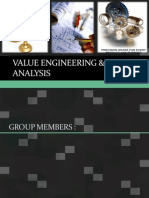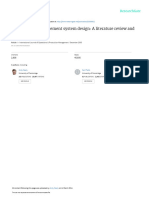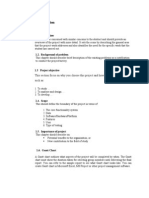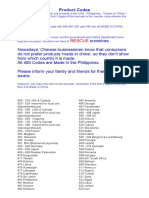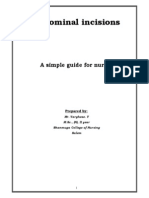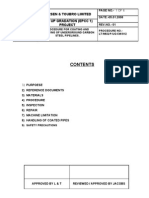VDI2221
VDI2221
Uploaded by
hansen_golsvokCopyright:
Available Formats
VDI2221
VDI2221
Uploaded by
hansen_golsvokOriginal Description:
Copyright
Available Formats
Share this document
Did you find this document useful?
Is this content inappropriate?
Copyright:
Available Formats
VDI2221
VDI2221
Uploaded by
hansen_golsvokCopyright:
Available Formats
INTERNATIONAL DESIGN CONFERENCE - DESIGN 2006
Dubrovnik - Croatia, May 15 - 18, 2006.
THE DEVELOPMENT OF THE GUIDELINE VDI 2221 -
THE CHANGE OF DIRECTION
J. Jnsch and H. Birkhofer
Keywords: design guidelines, design methods research, development
of design guidelines
1. Introduction
Design guidelines have been developed over the past 50 years. Analyzing this development gives
interesting insights into the changing character of the design guidelines. Special insights are obtained
concerning the intention and direction of the guidelines. These insights give, on the one hand,
explanations for the still reserved application and acceptance of design guidelines, and on the other
hand, evidence of their improvement. This paper aims to give an overview of the development of the
design guidelines in German-speaking lands, point out certain aspects of changes (aim, advice,
instructions, terminology, and description) and provide ideas about the consequences and potentials of
these changes.
2. Objectives: Guidelines for Inventiveness and Designing
This chapter will introduce the relevant guidelines that have contributed to and influenced the
guideline VDI 2221. The guidelines and the persons who have created them can be seen as connected
in one way or another because the majority of the persons mentioned have known each other and
worked together in the VDI-Committee Konstruktionsmethodik ("design methodology"). Therefore,
the four following guidelines can be thought of as a coherent development.
2.1 Guideline for invention according to Kesselring
The first guideline for inventions was developed by Fritz Kesselring [Kesselring, 1954] in 1954. In his
book Technische Kompositionslehre, he describes a guideline named Guideline for inventions
(Wegleitung zur Erfindung) based on his own practical experiences. His aim was to identify
conditions and operations of a successful invention and externalize them in an inventive science
(Erfindungslehre).
In order to derive an inventive science, he analyzes his own inventions incipient with the invention
of an oil circuit breaker to a disconnect switch. His analysis ends with a guideline presented in figure
1. The aim of the guideline from Kesselring is to propose aspects of inventions which are common to
all invention processes. The content of this guideline is directed at the individual designer, his
situation and gives advice concerning thinking and acting processes.
The considerations for this guideline are only based on the personal invention experiences of
Kesselring. The guideline suggests to associate, to set up analogies and to have breaks. Furthermore,
the guideline recommends freeing oneself of prejudice and existing solutions. It also gives
instructions, such as to study the domain-specific literature and patents and to make notes and sketches
THEORY AND RESEARCH METHODS IN DESIGN 45
of all ideas that come up. Regarding the terminology in this guideline, only "household" words are
used. The description of the guideline is text-based only (see figure 1).
1. Study of the technical literature, patent specifications and relevant propaganda material together with the
legalities associated however lightly with the problem at hand.
2. Working out of the technical and economic shortcomings of previous solutions.
3. Liberation and disengagement from all existing prejudices.
4. Getting perpetually caught up in the conviction, bordering on an obsession, that one can find something better.
5. Weighing up all the physical legalities, technological experiences, and possibilities that intuitively come to
mind for a solution, whereupon one should not initially shrink away from combinations that seem absurd.
6. Conscious utilization of the physical-mental-emotional state favorable to inventing. Typical of this is that floating,
often dreamy state that is punctuated by moments of clarity but forsaking all logical, particularly mathematical,
considerations.
7. The immediate capture of all ideas, aphorisms, associations, analogies, etc., however vague, in the form of key
words and sketches.
8. Taking a break to get back into a creative frame of mind; blocking, even almost forgetting what one has
previously worked out, and yet always being certain that the right idea will come to mind sooner or later.
9. Catching and when possible recording inventive ideas, which hit one most often like a sudden flash, together
with the thought associations, realization possibilities, modifications, etc. that accompany such ideas in torrents.
10. Relaxation, review of visions, overcoming the ever-present disillusionment, examining the realization possibilities,
or, in the event that the idea proves not to be sound enough, starting over from square one.
Figure 1. Guideline for inventions [Kesselring 1954]
2.2 Basis system with four development steps according to Hansen
The second guideline was proposed by Hansen [Hansen 1965] in 1965 in the book
Konstruktionssystematik.
The basis system is based on a system-oriented view (see figure 2). The experiences and ideas were
gained at Carl Zeiss JENA together with his employees and researcher Bischoff and Bock. Hansen
talks of a basis system that is founded on the relationships between the task and facts of successful
solutions. According to Hansen, there are indispensable regularities and patterns in the development
process [Hansen, 1965]. These regularities provide the foundation for instructions and logical
sequences of thoughts and actions. The aim of the progressive plan was to make the flow of work
more effective and efficient. In particular, he urges one to think logically and proceed systematically.
The formulation of the guideline according to Hansen is directed at an individual designer as well as
general engineering work on an technical level.
The guideline contains the step of failure criticism. This step offers advice about the possibility to
improve existing solutions. Further, he stresses the necessity for iterations and for putting something
down in writing. The thinking process is described in the book on a very result-oriented level; the
thinking process during designing is analyzed as a creative act. But it is not addressed in the figure and
the text of the guideline. The instructions of this guideline are on a technical level and basically
oriented on a logical proceeding and the search for an efficient solution. The instructions in the figure
and the text are quite short.
Accordingly, the terminology in this guideline is mainly technical. The termini basic principle,
working principles and concept are used. They are defined and in advances, especially, the termini
designing, concepting, defining, etc. But Hansen addressed and discussed the problem of terminology
within the field of designing. He tried to define and separate them from household words. The
description of this guideline is figure- and text-based (see figure 2). The text is very close to the figure
and contains some supplementary information and explanations.
46 THEORY AND RESEARCH METHODS IN DESIGN
1. Determine the kernel of the task, because this all
solutions in common (basic principle).
2. Combine all possible assembly elements efficiently, because
all solutions consist of such combinations (working principles).
3. Determine all the defects of the solutions and strive to reduce
their effects (improved working principle).
4. Establish the solution with the minor defects
(optimum working principle).
5. Create documents, that provide the practical use.
Task
System-
study
Considerations
Basic principle
GPr
synthesis
System-
Search and combination
of solution elements
Working operations / -principles
AW AW AW
System-
analysis
Failure critics
Improved working operation
VAW VAW VAW VAW
evaluation
System-
Valence comparison
Optimum working operation
OAW
Concept
Figure 2. Stepped procedure [Hansen 1954]
2.3 The Guideline VDI 2222
In 1973 the guideline VDI 2222 Design engineering methodics Conceptioning of industrial
products was set up on the proposals of Kesselring and Hansen by the VDI (Association of German
engineers), the committee design methodology [Kesselring 1971]. Chairman of this group was Fritz
Kesselring. So, the VDI 2221 was based on the practical experiences and scientific considerations of
several professors. Among these were Beitz, Koller, Kollmann, Pahl, Rodenacker, and Roth. VDI
2222 was intended as a guideline to develop technical products in practice as well as a contribution for
design education [VDI-Richtlinie 2222 1973]. The aim of this guideline is to provide a procedure for
designing that is valid from precision mechanics to electrical engineering [VDI-Richtlinie 2222 1973].
The guideline is based on problem-solving processes and influenced by cybernetics. One desire for
this guideline was to give designing a more scientific basis. Also, a central idea of the guideline was to
assign design methods to the different design phases. The guideline encompasses the four main design
phases: clarification of the task, conceptual design, embodiment design and detail design. Figure 3
shows this process with its steps. At every step, a decision has to be made as to whether the next step
can be taken or whether previous steps have first to be repeated [Pahl, 1984].
The advice especially concerns the iterations and the adaptation of the requirements list during the
complete design process given on the sides of the figure (see figure 3). Additional advice for the
designers is given in the so-called Weidruck of the guideline, a 52-page text with detailed
information about the guideline, examples of the application of the guidelines and relevant literature.
The detailed information includes, for example, checking questions to establish the specifications.
What are the wishes and expectations of customers that are not mentioned? To what aim does the
THEORY AND RESEARCH METHODS IN DESIGN 47
solution strive? What properties of the solution are not allowed? Also, the problem of freeing oneself
from prejudice is addressed there. The Weidruck states: To free oneself of fixation on solutions, it
is advisable to start with the abstraction of the task [VDI-Richtlinie 2222]. The instructions are
action-based and procedure-oriented and are directed at finding a solution. The actions steps are
divided in actions and decisions. The formulation of the instructions is abstract, such as setting up a
function structure or searching for solution principles.
The terminology in this guideline is rather abstract and technical. New termini like requirements list,
function structure, and concept variants were generated. The description is based on figures and text. The
text (Weidruck) that belongs to the VDI 2222 gives detailed descriptions of the procedure itself and
the thinking process. Remarks are made about the thinking process, intuitive and descriptive thinking,
goal-oriented thinking, and thinking failures. Also, one can find basic methods (also called heuristics),
such as method of questioning, method of negation and new conception, method to move forward,
method to move backwards, etc. [VDI-Richtlinie 2222, 1973]. Within these methods concrete advice
is given on what one might specifically do while searching for solutions.
Task
Clarification of
Clarify the task
the task
Elaborate the specification
Specification
Optimisation of the principle
Identify essential problems
Conceptual
design
Establish function structures
Search for solution principles
Combine and firm up into concept variants
Evaluate against technical and economic criteria
Information: adapt the specification
Concept
Upgrade and improve
Optimisation of the layout and forms
Develop preliminary layouts and form designs
Select best preliminary layouts
Refine and evaluate against technical and economic criteria
Embodiment design
Preliminary layout
Optimise and complete form designs
Check for errors and cost effectiveness
Prepare the preliminary parts list and production document
Definitive layout
Detail design
Finalise details
Complete detail drawings and production documents
Check all documents
Documentation
Solution
Figure 3. Guideline VDI 2222 [VDI-Richtlinie 2221 1993]
48 THEORY AND RESEARCH METHODS IN DESIGN
2.4 The Guideline VDI 2221
In 1993 the VDI 2222 guideline was replaced by the VDI 2221 guideline Systematic approach to the
development and design of technical systems and products [VDI-Richtlinie 2221 1993]. The guideline is
still based on VDI 2222. The goal of this guideline is to propose a general methodology for designing
technical systems and products and to support a methodical and systematic designing, in order to
produce a more efficient working style. The guideline is independent of the branch and addresses
content and organizational aspects of designing. It stresses the broad application within mechanical
engineering, precision mechanics, switches and software development and the planning of process
engineering [Pahl, 2003]. The guideline is based on systems engineering and problem-solving.
One main aspect of it is the integral data processing and the application of CAD. This aspect takes up
a third of the description in the Weidruck.
The remaining advice addresses the iterations of the process and the adaptation of the requirements list
during the whole process (see figure 4). The advice in the Weidruck of the guideline contains more
results of research than practical hints for thinking and acting. This means that the checking questions,
for example, have changed into the requirements of a good problem-solver. So, the Weidruck
contains a paragraph with the research results of a successful designer [VDI-Richtlinie 2221, 1993].
The checking questions like those in VDI 2222 as well as the advice concerning the thinking process
are omitted. The instructions of VDI 2221 compared to VDI 2222 are reduced to establish the
function and their structures, search for solution principles and their structures and structure in
modules (see figure 4). The terminology is more abstract then in VDI 2221. Especially the termini
modules and module structure are introduced. The description is demonstrated pictorially with the flow
chart and the Weidruck text. The Weidruck encompasses 42 pages. In the figure it is only
differentiated between instruction and working results. The steps of decisions have been omitted.
Stages Results Phases
Task
Clarify and define
Iterate towards and backwards between previous and following stages
1 Phase I
The task
Specification
Determine functions
2
and their structure
Function structures
Search for solution principles Phase II
3
and their combinations
Fulfil and adapt requirements
Principal solutions
Divide into
4
realizable modules
Module structures
Develop layout of
5 Phase III
Key modules
Preliminary layouts
Complete overall
6
layout
Definitive layouts
Prepare production and Phase IV
7
Operating instructions
Product documents
Further realisation
Figure 4. Guideline VDI 2221
THEORY AND RESEARCH METHODS IN DESIGN 49
3. Changes and Alternations of the Guidelines
The analysis of the four guidelines point out the change and alternation of the aim, the basis, the
direction, the advice, the instructions, the terminology and the method of description. Comparing these
aspects during the development from the procedure for inventions according to Kesselring to the VDI
2221, some remarkable changes and alternations have come to pass. These changes and their
consequences for the effect of the guidelines on individual designers will be considered in the next
four sections.
3.1 Changes of basis, aims and direction
The basis of the guideline started with Kesselring with personal experiences and the search for
constant facts during the act of invention. Hansen has already gathered his experiences with two other
persons (Bischoff and Bock in Carl Zeiss Jena). The VDI guidelines are the product of more then ten
persons' scientific and practical experiences. Kesselring created the guideline by transforming the
porcedure and the incidences of his inventions. Hansen established his guideline already more on the
system idea and methodological thought, like the title and foreword of his book illustrate (design
systematic). The VDI guidelines focus more and more on system engineering, problem-solving, and
cybernetics, partly dependent on the desire to give designing a stronger scientific foundation. The aim
of the guideline to support a more efficient and foreseeable invention process has changed and
broadened towards a support of the complete design process in a company where many types of
people, not only designers, are involved. The generality inherent in all guidelines has been greatly
increased and currently implemented. The direction of the guidelines has changed from a personal
support for individuals (Kesselring) towards a general procedure for a company addressing
organization and content (VDI 2221).
3.2 Change of advice
The advice in Kesselrings guideline addresses the individual designer in his/her thinking, acting, and
actual situation. Already the guideline from Hansen and his employees have become much more
technically oriented. They certainly give advice for iteration and failure criticism, but there is already
much information based on research results. VDI 2222 has besides the iterations and the continuous
adaptation of the specification no advice in the flow chart, but gives comprehensive and firsthand
advice in the Weidruck that are immediately practicable. VDI 2221 retains the advice in the flow
chart but has reduced the firsthand advice in the Weidruck decisively in favor of the research results
and computer support in design. The advice within the guidelines have changed from addressing
concrete thinking processes to general problem solving advice. Kesselring suggests associating and
setting up analogies as well as searching in failures, etc. VDI 2221 suggests making iterations and
adapting the requirement list continuously.
3.3 Change of instructions
The instructions have changed from statements that can be immediately put into action or thought to
instruction on an abstract level, which need to be adapted to the current situation of the designer. For
example, Kesselring instructs designers to study domain-specific literature and patent and write ideas
down. VDI 2221 instructs the designer on establishing a function structure or structure modules.
3.4 Change of termini
The termini within the guidelines have changed from household words into newly created abstract
technical termini. Kesselring was working with household words. Hansen already switched to
technical termini, which he established and defined (basic principle, working principles and concept).
He mentioned the problems in finding the suitable terms in the domain of designing. In order to
provide generality, new termini were needed. The VDIs introduce new termini, guided by their new
insights and methods (e.g. function structure) and the pursuit of generality. Furthermore, it is difficult
to agree on a certain term within such a large working group like the VDI working group, and this also
50 THEORY AND RESEARCH METHODS IN DESIGN
leads to more abstract and general termini. This development of termini already shows that there is a
central need in design to find, use and create suitable termini, which are understandable and not
misleading. Nowadays, there is a mixture of daily terms (function, modules) and newly generated
technical terms (concept, specification). An additional problem in this field arises on account of the
fact that one term has different meanings in different knowledge domains in which the guidelines can
be applied (mechanical engineering, system engineering, etc.). The problem increases when
translating new technical termini into other languages.
3.5 Changes of descriptions
The appearance of the descriptions of the guidelines have altered from a pure one-page text-based
description to comprehensive descriptions with figures, in particular flow charts and in-depth texts.
The content of the descriptions has been enhanced with figures, examples and a quantity of text. An
important role is taken on by the figures, especially by the flow charts of VDI 2222 and VDI 2221. In
books, presentations, seminars and lectures one usually finds the flowchart of the VDIs, but seldom
the complete text of the Weidruck. So, the flow charts have become the dominant and focused part of
the guideline, also because human cognition responds more to figures and perceives and remembers
figures better. Due to this fact, a loss of important information takes place. The analysis of the content
in the Weidruck has shown that there is much information in particular for the human thinking
process, which is missing in the figures and is only mentioned in the Weidruck.
The insights of designing and the design process have increased considerably over the last 50 years.
These insights of generality, requirements, computer-based support, suitable structures, etc. have been
integrated in the descriptions, but the figures are company- and process-oriented and so the directly
applicable information for individual designers are placed in the background.
4. Result: The development from an individual towards a company directed design
guideline
The analysis of the guidelines has shown that a development from individual thinking and acting to a
holistic, general and company-oriented direction has taken place (see figure 5). The idea and the wish
to put designing on a scientific level has to a large extent been realized. The striving for generality of
the guideline in different branches has been realized in the guideline by the abstract terminology and
the formulations of the (technical) logical processes. The research results in designing are
implemented in the guideline with the intention of implementing them in practice. Therefore, the
individual designers have taken a back seat regarding the guidelines and their descriptions.
Especially within the figures of the guidelines the individual designers have taken second place to
company-directed aspects. The advice concerning thinking and action has dwindled and become more
abstract and been placed in the textual description. The same has happened to the instructions; they
have become more abstract and abridged. The terminology has changed from household words
understandable by everybody to new abstract and technical termini that require considerable
background knowledge for a correct interpretation.
Description of design guideline
Directed to individual designers Directed to the whole company
Thinking/acting oriented advices Problem solving oriented advices
Direct instructionsDasdfdasdf
Adsfas
Asdf
Abstract instructions
Household words Asdf
Asdfsasfa
asdfeewe
Abstract, technical termini
Text based Figure and text based
Tas k W ork ing re sults Phase s
z u eine moder meh rerenArb eit sa bsc hn itt en
1 Clarify task Phas e I
Text trdz zrdz#dsdsd
Spec if ic at ion
2
Elabo rate fu nc tions
and t heir s tructu re s
Textzrdzsdfgfsdfgsd
F u nc tion stru ct ur e
Textdzrdzsdfgfdsdfg
Erf llenund An pas sender An fo rd erungen
Gaining research
Se ar ch for solu tio n principles Ph ase II
3
and t heir s tructu re s
Principal s olu tions
Textsdzrszsdfgsdfgsd
4
Su bdivid e in
rea lizab le m o du le s
Mod ularise d
Textszrsdzrsdzrrrrds
It erat ive sVor- o de rRc kspring en
G e stalten d er
S tructu re s
Zrdwegdbfnrertwert
results in designing
5 Ph as e II I
ma ge blich en Mo dule
Voren twrfe Wertdsfvsfhrtsdefvd
Gestalte n de s ge sam te n
6
Produkts
Gesamt -
entwrfe
Shrdsfsbszrdshrsdf
7
Au sa rb eit en der Ausf hrung s-
u nd Nu tzun gs ang aben
Produ kt-
Ph ase IV
sertewsedfvsdbsbs
d oku men ta tio n
W eitere Rea lisierung
Development of the design guidelines
Figure 5. The development of changes in the guidelines
According to this development, the demands on designers who should work with the guidelines have
been increased. The designers have to have a holistic and comprehensive view of the design process to
have an adequate understanding of the guideline and to adopt and apply it appropriately. Furthermore,
THEORY AND RESEARCH METHODS IN DESIGN 51
they must be familiar with the complete guideline: figure, text and terminology. When applying the
guideline, they have to adopt the abstract instructions and advice into their thinking and acting
processes and the current situation. The first guidelines certainly contain less information and research
results, but they seem easier to understand and to apply to the individual designer. So, most of the
identified changes might cause acceptance and application problems of design methods in industry.
From this point of view, it seems to be considerable to let science, industry and teaching come closer
together and seek for useful chances for all the parties.
5. Conclusion and Outlook: Consequences of this development for the
understandability and acceptance of design methods
The consequences that could be concluded from these considerations is that science, industry und
teaching have to work closer together in order to bridge the gap between the offered design methods
by science and the demanded methods from industry. This means, that science has to transform the
scientific results into concrete instructions for action in the guideline. Further, science has to focus
more on the actual problems in industry. To gain experience, science has to go into industry and adopt
their methods and collect impressions what are the demand of methods in industry [Birkhofer et. al.
2005]. For VDI 2221 this would mean generating an additional description of the guideline that is
directed and adopted to the individual designer and to the identified problems. This description should
include a figure that points out the most important facts for the work (thinking and acting) of the
designer, which are already mentioned in the Weidruck of both VDI guidelines. The teaching of
design methods has to be taught more method-suitable in order to train the abstraction of design
methods and their adaptation. These contemplations do not criticize the development of the guidelines
and the guidelines itself. Rather, they should serve more as a reminder that there are many important
and valuable research results for the individual designer in all of the guidelines contained, but not
effectively used.
References
Birkhofer, H., Jnsch, J. und Kloberdanz, H. An extensive and detailed view of the application of design
methods and methodology in industry. In: Samuel, A. and Lewis, W. (Hg.). ICED 2005 Proceedings. Australia,
Melbourne, 2005.
Kesselring, F., "Technische Kompositionslehre", Springer, Berlin, 1954.
Hansen, F., "Konstruktionssystematik", VEB Verlag, Berlin, 1966.
Kesselring, F., Winterthur, A. Methodisches Planen, entwickeln und Gestalten technischer Produkte,
Konstruktion 22, 1971, pp.121-128.
Beitz, W. Mglichkeiten methodischer Lsungsfindung in der Konstruktion, Konstruktion 23, 1971, pp. 161-
167.
Pahl, G., Beitz, W., Engineering Design, Springer-Verlag, Berlin, Heidelberg, New York, Tokyo, 1984.
VDI-Richtlinie 2222, Konzipieren technischer Produkte VDI-Verlag, Dsseldorf, 1973.
VDI-Richtlinie 2221, Methodik zum Entwickeln und Konstruieren technischer Systeme und Produkte, VDI-
Verlag, Dsseldorf, 1993.
Pahl, G., Beitz, W., Konstruktionslehre, Grundlagen erfolgreicher Produktentwicklung, Methoden und
Anwendung, Springer, Berlin, Heidelberg, 2003.
Dipl.-Wirtsch.-Ing. Judith Jnsch
Research Assistent
Darmstadt, University of Technology, product development and maschine elements (pmd)
Magdalenenstr. 4, 64283 Darmstadt, Germany
Tel.: + 49 (0) 6151 16 3055
Fax.: + 49 (0) 6151 16 3355
Email: jaensch@pmd.tu-darmstadt.de
URL: http://www.pmd.tu-darmstadt.de
52 THEORY AND RESEARCH METHODS IN DESIGN
You might also like
- Manufacturing Facilities Design & Material Handling: Sixth EditionFrom EverandManufacturing Facilities Design & Material Handling: Sixth EditionRating: 4 out of 5 stars4/5 (1)
- Function AnalysisDocument4 pagesFunction AnalysisWanAtikatulAsmaNo ratings yet
- Radial Wave Function and Angular Wave FunctionsDocument8 pagesRadial Wave Function and Angular Wave FunctionsBhavesh Garg100% (4)
- BTEC HND Unit 2 Marketing Essentials Assignment 1Document18 pagesBTEC HND Unit 2 Marketing Essentials Assignment 1Suranga Samaranayake100% (1)
- Should We Risk It?: Exploring Environmental, Health, and Technological Problem SolvingFrom EverandShould We Risk It?: Exploring Environmental, Health, and Technological Problem SolvingRating: 1 out of 5 stars1/5 (1)
- ISA-95 Integration Standards A Complete Guide - 2019 EditionFrom EverandISA-95 Integration Standards A Complete Guide - 2019 EditionNo ratings yet
- ISA 95 Integration Standards A Complete Guide - 2021 EditionFrom EverandISA 95 Integration Standards A Complete Guide - 2021 EditionNo ratings yet
- Failure Analysis: A Practical Guide for Manufacturers of Electronic Components and SystemsFrom EverandFailure Analysis: A Practical Guide for Manufacturers of Electronic Components and SystemsNo ratings yet
- Design For Manufacture And Assembly A Complete Guide - 2020 EditionFrom EverandDesign For Manufacture And Assembly A Complete Guide - 2020 EditionNo ratings yet
- Manufacturing Execution System A Complete Guide - 2020 EditionFrom EverandManufacturing Execution System A Complete Guide - 2020 EditionNo ratings yet
- Manufacturing Execution System A Complete Guide - 2019 EditionFrom EverandManufacturing Execution System A Complete Guide - 2019 EditionNo ratings yet
- Modeling and Simulation Support for System of Systems Engineering ApplicationsFrom EverandModeling and Simulation Support for System of Systems Engineering ApplicationsLarry B. RaineyNo ratings yet
- Systems Engineering: A 21st Century Systems MethodologyFrom EverandSystems Engineering: A 21st Century Systems MethodologyRating: 4 out of 5 stars4/5 (2)
- Configuration Management System A Complete Guide - 2019 EditionFrom EverandConfiguration Management System A Complete Guide - 2019 EditionNo ratings yet
- Systems engineering: understand each other to engineer togetherFrom EverandSystems engineering: understand each other to engineer togetherNo ratings yet
- Advanced Driver Assistance Systems (ADAS) Standard RequirementsFrom EverandAdvanced Driver Assistance Systems (ADAS) Standard RequirementsNo ratings yet
- CHMT5011 Oil and Gas Engineering Design 2017 Lecture NotesDocument116 pagesCHMT5011 Oil and Gas Engineering Design 2017 Lecture NotesAbdulsalam JibrilNo ratings yet
- SAD1Document34 pagesSAD1tlbbkhyt620No ratings yet
- Architecture Design Course-Brochure RGB 220726-1Document4 pagesArchitecture Design Course-Brochure RGB 220726-1Farah AhmedNo ratings yet
- 2015 - IDETC - Booth Et AlDocument9 pages2015 - IDETC - Booth Et AlHasibur Rahman PiyashNo ratings yet
- Method Study Is The Systematic Recording and Critical Examination of Ways of Doing Things in Order To Make ImprovementsDocument4 pagesMethod Study Is The Systematic Recording and Critical Examination of Ways of Doing Things in Order To Make ImprovementsManjesh ThilakNo ratings yet
- Topic 01 - Introduction To ORDocument29 pagesTopic 01 - Introduction To ORimran_chaudhryNo ratings yet
- Designing Requirements Engineering ResearchDocument12 pagesDesigning Requirements Engineering ResearchMb Arguelles SarinoNo ratings yet
- Sketching in Early Conceptual Phases of Product Design: Guidelines and ToolsDocument6 pagesSketching in Early Conceptual Phases of Product Design: Guidelines and ToolsSadullah AvdiuNo ratings yet
- Preliminary PhaseDocument3 pagesPreliminary PhaseBruno CorreiaNo ratings yet
- A Review of The Fundamentals of The Systematic Engineering Design Process ModelsDocument13 pagesA Review of The Fundamentals of The Systematic Engineering Design Process ModelsAnonymous N3LpAXNo ratings yet
- Components of Problem Solving and Types of Problems.: September 1994Document21 pagesComponents of Problem Solving and Types of Problems.: September 1994AlanNo ratings yet
- Performance Measurement System Design A LiteratureDocument37 pagesPerformance Measurement System Design A LiteratureAkram DjeNo ratings yet
- Value Engineering & Value AnalysisDocument49 pagesValue Engineering & Value AnalysisFaran ShaikhNo ratings yet
- Process PatternsDocument18 pagesProcess PatternsdorinmunNo ratings yet
- CM2020 ASP FinalDocument3 pagesCM2020 ASP FinalPrasannaNo ratings yet
- Lecture 01 Work System Design-IntroductionDocument12 pagesLecture 01 Work System Design-IntroductionrbansalNo ratings yet
- Performance Measurement System Design A LiteratureDocument37 pagesPerformance Measurement System Design A Literaturedanny902No ratings yet
- 260CT Revision NotesDocument30 pages260CT Revision NotesSalman Fazal100% (4)
- Jurnal VDI 2222Document4 pagesJurnal VDI 2222yumna salmaNo ratings yet
- Software Engineering Guiding PrinciplesDocument12 pagesSoftware Engineering Guiding PrinciplesGikonyoNo ratings yet
- Chapter 1 Introduction: Project OverviewDocument5 pagesChapter 1 Introduction: Project OverviewmrkhaireeNo ratings yet
- Implementation of Functional Analysis Using Value Analysis Value Engineering (Vave) On Car Outside HandleDocument6 pagesImplementation of Functional Analysis Using Value Analysis Value Engineering (Vave) On Car Outside HandleEditor IJTSRDNo ratings yet
- Matlab CourseDocument91 pagesMatlab Coursemike110*No ratings yet
- QUARTILEDocument10 pagesQUARTILEdonna b. emata100% (1)
- Filter Design ParameterDocument3 pagesFilter Design ParameteruemaaplNo ratings yet
- Articleship Interview GuideDocument21 pagesArticleship Interview GuideM Ali ArifNo ratings yet
- Symmetry Volume XIII: Preliminarily Editor Selection ProcessDocument2 pagesSymmetry Volume XIII: Preliminarily Editor Selection ProcessSagar RawalNo ratings yet
- Target Product Profiles For Tuberculosis Preventive TreatmentDocument46 pagesTarget Product Profiles For Tuberculosis Preventive TreatmentMoelyha Viani AndariniNo ratings yet
- Human FighterDocument3 pagesHuman FighterJeff SlickNo ratings yet
- Performance Appraisal Goals ExamplesDocument6 pagesPerformance Appraisal Goals ExamplesKyle annieNo ratings yet
- Gravure - Cylinders - Parts 1-3 PDFDocument18 pagesGravure - Cylinders - Parts 1-3 PDFhabteyes abateNo ratings yet
- Why Did ABC Fail at The Bank of ChinaDocument9 pagesWhy Did ABC Fail at The Bank of ChinaZhang JieNo ratings yet
- UWI Today 75th Anniversary of The UWI Digital Issue December 2023Document24 pagesUWI Today 75th Anniversary of The UWI Digital Issue December 2023Jacqueline Laguardia MartinezNo ratings yet
- Demographic EffectsDocument24 pagesDemographic EffectsFery FebriansyahNo ratings yet
- Product Codes-Made in ChinaDocument3 pagesProduct Codes-Made in ChinaMaimai AnievasNo ratings yet
- Stunting TreatmentDocument10 pagesStunting TreatmentDiana etika azzahraNo ratings yet
- Ecdis and Spas OperationDocument3 pagesEcdis and Spas OperationRhamsia AlquirozNo ratings yet
- Icc Esr-2302 Kb3 ConcreteDocument11 pagesIcc Esr-2302 Kb3 ConcretexpertsteelNo ratings yet
- Using A fUML Action Language To Construct UML ModelsDocument9 pagesUsing A fUML Action Language To Construct UML ModelslcodrutlucianNo ratings yet
- Abdominal Incisions: A Simple Guide For NursesDocument25 pagesAbdominal Incisions: A Simple Guide For Nursesfaris.surgeonNo ratings yet
- Soccer Skills and DrillsDocument3 pagesSoccer Skills and Drillsapi-319531999No ratings yet
- Commercial BankDocument69 pagesCommercial BankAnjali Sharma83% (6)
- Driving Test Slot ConfirmationDocument3 pagesDriving Test Slot ConfirmationSudeep JasonNo ratings yet
- How To Get Started With Sap ConnectDocument11 pagesHow To Get Started With Sap ConnectmatinoNo ratings yet
- 12 Procedure For Coating Wrapping Rev 01Document6 pages12 Procedure For Coating Wrapping Rev 01dnbinh100% (2)
- Entrepreneurship EducationDocument4 pagesEntrepreneurship EducationJardo de la PeñaNo ratings yet
- PRACTICAL 4: The Staining of Microorganisms - Capsule Staining and Spore StainingDocument2 pagesPRACTICAL 4: The Staining of Microorganisms - Capsule Staining and Spore StainingSyamim LazimNo ratings yet
- Indian Biogas Association Biogas Market IndiaDocument36 pagesIndian Biogas Association Biogas Market Indiasj singh100% (1)
- "Use of Ict in Teaching and Learning": Assignment OnDocument6 pages"Use of Ict in Teaching and Learning": Assignment OnapplebascoNo ratings yet
- SSD - BCDocument14 pagesSSD - BCAndreea UniNo ratings yet
- Sourcing Decisions in A SCDocument45 pagesSourcing Decisions in A SCShahmirBalochNo ratings yet



















































